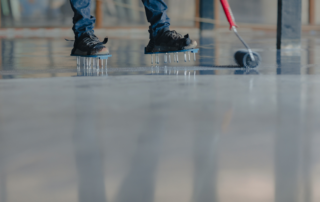Introduction
Welcome to the world of Polyaspartic floor coatings, a groundbreaking technology that’s setting new standards in the flooring industry. Whether you’re a homeowner looking to revamp your garage, a business owner in need of a durable flooring solution, or a contractor seeking the latest and greatest, this guide is your ultimate resource. We’ll delve into the nitty-gritty of Polyaspartic floor coating, its costs, potential problems, and how it compares to other types of coatings like polyurea and epoxy.
What is Polyaspartic?
Polyaspartic is a specialized type of aliphatic polyurea coating. Developed in the late 1980s, this protective layer is a chemical concoction of isocyanate and a Polyaspartic ester, which is a derivative of aspartic acid. Initially, this technology was developed to protect steel from corrosion, but its application has expanded dramatically. Today, it’s used in various settings, from residential garages to industrial warehouses. The coating bonds exceptionally well to concrete surfaces, providing a glossy, chemical-resistant finish that’s also resistant to abrasion and UV radiation. It’s a two-part system consisting of a polyurea base coat and an aliphatic polyaspartic top coat, which offers superior performance compared to traditional coatings.
Polyaspartic Garage Floor Cost
When it comes to flooring solutions, polyaspartic coatings are generally more expensive upfront. The cost isn’t just about the material; it’s also about the labor involved. Unlike simpler options, a polyaspartic floor requires an epoxy primer followed by a polyaspartic finish coat. This multi-layer process adds to the overall cost. However, considering its long lifespan and minimal maintenance, many see it as a long-term investment. On average, the cost can range from $3 to $7 per square foot, depending on various factors like the existing floor’s condition, the job’s complexity, and your geographic location.
Polyaspartic Garage Floor Problems
Acid Vulnerability
While polyaspartic coatings are robust, they are not invincible. One of their vulnerabilities is their susceptibility to acid corrosion. The molecular structure of polyaspartic coatings contains weak bonds that can break down when exposed to acidic compounds, compromising the integrity of the coating.
Moisture Sensitivity
Another issue to consider is the coating’s sensitivity to moisture. High moisture levels can affect the coating’s adhesion to the floor, leading to problems like bubbling, peeling, and lifting from the surface. This is particularly concerning in environments with fluctuating humidity levels.
Slippery When Wet
The smooth, glossy surface of polyaspartic coatings can become slippery when wet. However, this issue can be mitigated by adding a non-slip additive to the coating before application. Some manufacturers offer polyaspartic coatings with built-in textures to address this issue.
Polyaspartic vs Polyurea
Both polyaspartic and polyurea coatings offer robust durability and longevity. However, polyaspartic coatings have the edge in terms of curing time and ease of maintenance. Polyurea coatings, while flexible and durable, often require a more extended period for application and curing, sometimes up to 48 hours. This can be a significant drawback for commercial settings where downtime needs to be minimized.
Polyaspartic vs Polyurea Floor Coating
When it comes to floor-specific applications, polyaspartic coatings are more specialized. They offer a two-part system that includes a polyurea base coat and an aliphatic polyaspartic top coat. This specialized system provides a higher level of gloss and chemical resistance compared to general-purpose polyurea coatings. Additionally, polyaspartic coatings are UV-stable, meaning they won’t yellow over time, unlike some polyurea coatings.
Pros of Polyaspartic Floor Coating
Quick Application
One of the standout features of polyaspartic coatings is their rapid curing time. Most projects can be completed within a few hours, making it ideal for businesses that can only afford short downtimes. This quick curing time also benefits homeowners who want to use their garage or other coated space as soon as possible.
Durability
Polyaspartic coatings are built to last. They offer resistance to abrasion, UV radiation, and chemicals. Their easy maintenance also adds to their longevity. A simple sweep and occasional mop are generally all that’s needed to keep the floor looking new.
Eco-Friendly
In a world increasingly concerned about the environment, polyaspartic coatings offer a greener alternative. They contain fewer volatile organic compounds (VOCs) compared to traditional epoxy coatings, making them less harmful to the environment.
Cons of Polyaspartic Floor Coating
High Cost
While polyaspartic coatings offer numerous benefits, they come at a higher initial cost compared to other options like epoxy. This can be a significant factor for budget-conscious homeowners or businesses.
Limited Color Options
If you’re looking for a wide range of colors, polyaspartic coatings might disappoint you. They usually come in limited shades, primarily grays and beiges. However, some manufacturers are expanding their color palettes to include more vibrant options.
Moisture Sensitivity
High moisture levels can be a deal-breaker for polyaspartic coatings. They require a completely dry surface for optimal adhesion. This can be a challenge in humid climates or areas prone to water exposure.
FAQs
What Makes Polyaspartic Coatings Eco-Friendly?
Polyaspartic coatings contain fewer volatile organic compounds (VOCs), making them less harmful to the environment.
How Do I Find a Contractor for Polyaspartic Garage Floor Installation?
A quick online search for “polyaspartic floor coating near me” should provide you with a list of qualified contractors in your area.
Can Polyaspartic Coatings Be Used Outdoors?
Yes, these coatings are UV-resistant, making them suitable for outdoor applications.
What Are the Maintenance Requirements for Polyprotic Floors?
Polyaspartic floors are easy to clean and maintain, requiring only regular sweeping and occasional mopping.
Conclusion
Polyaspartic floor coatings are a robust, durable, and versatile solution for a variety of flooring needs. While they come with a higher initial cost and some limitations, their long-term benefits often make them a worthwhile investment. Whether you’re a homeowner looking to upgrade your garage or a business owner in need of a resilient and quick-to-install floor, polyaspartic coatings are an option worth considering.

